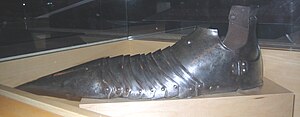Iron shoe
The iron shoe (also Soleret , Panzerschuh , Bärlatsch , English : Sabaton ) is part of the medieval or Renaissance armor .
description
The iron shoe appeared in the first half of the 14th century, but during this time only in connection with the leg tube (Diechling) to which it was attached or was part of it. It has its origins around the 13th century when a fixed, horizontal plate was attached to the leg tubes, which lay over the chain armor of the feet and served to protect the forefoot. This plate was fixed to the heel with a leather strap. The simple mercenaries at that time wore simple leather shoes that were shod with metal plates. With the advancement of armor , the shape of the armored shoes also changed . They became increasingly pointed on the toe part until they were formed into a long, slightly downwardly curved, pointed “spike” (armored shoe). The sting has different lengths. Among other things, it served to secure the foot from slipping out of the stirrup, as the knights in the plate armor became more and more immobile. These beak shoes came in different designs. Initially, they were firmly attached to the shoe, but with increasing length they were also made removable, as walking with the long, downward-curved spikes became impossible. In Italy these beaks were made from wood covered with leather. They were only attached to the shoe and fastened with pivot bolts when the rider was on the horse. These pointed shoes lasted until around 1490.
At the end of the 15th century, a reform for iron shoes was introduced by the Roman-German King Maximilian I and Margrave Albrecht Achilles of Brandenburg. The forms that developed from it took on grotesque , clumsy forms. The front foot end became many times wider until they took the shape of a duck's foot . These forms were called "cow's mouth", "bear foot" (French Pied d'ours ) or "duck foot".
Around 1560, the shapes normalized and became similar to normal shoes again. In the time that followed, the armorer tried to make the iron shoe more comfortable for the wearer. In order to make the shoes more mobile, the metal was provided with “pushes” ( pushed ). First a push , a kind of joint, was attached to the metatarsus (instep pushes), then to the toes (ball pushes) and finally on the leg at the level of the ankle (ankle pushes). With the end of armor, iron shoes lost their importance as a protective weapon.
literature
- Auguste Demmin : The historical development of war weapons from the Stone Age to the invention of the needle gun. A handbook of armory. Seemann, Leipzig 1869.
See also
Web links
Individual evidence
- ↑ Pons
- ↑ Wendelin Boeheim : Handbook of Armament. The weapon system in its historical development from the beginning of the Middle Ages to the end of the 18th century (= Seemanns Kunstgewerbliche Handbücher. Vol. 7, ZDB -ID 53757-3 ). Seemann, Leipzig 1890, pp. 118-119 (reprint. Fourier Verlag, Wiesbaden 1985, ISBN 3-201-00257-7 ).

